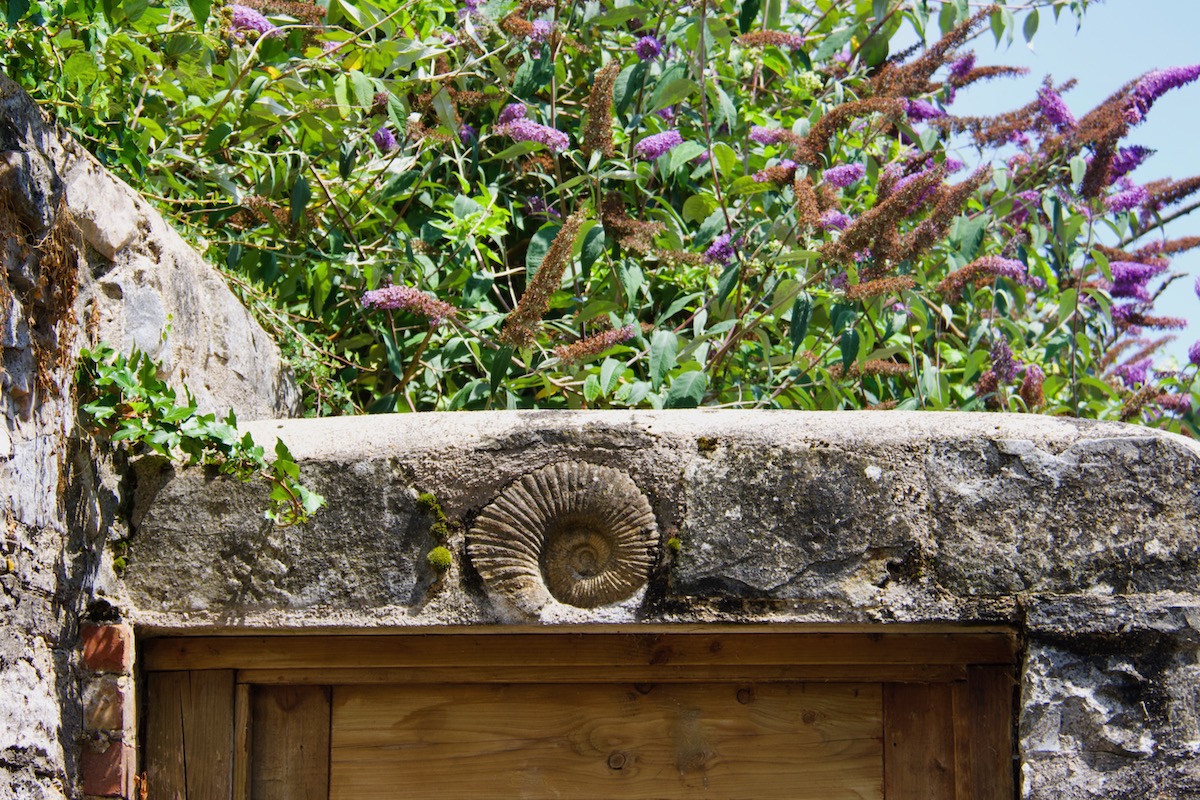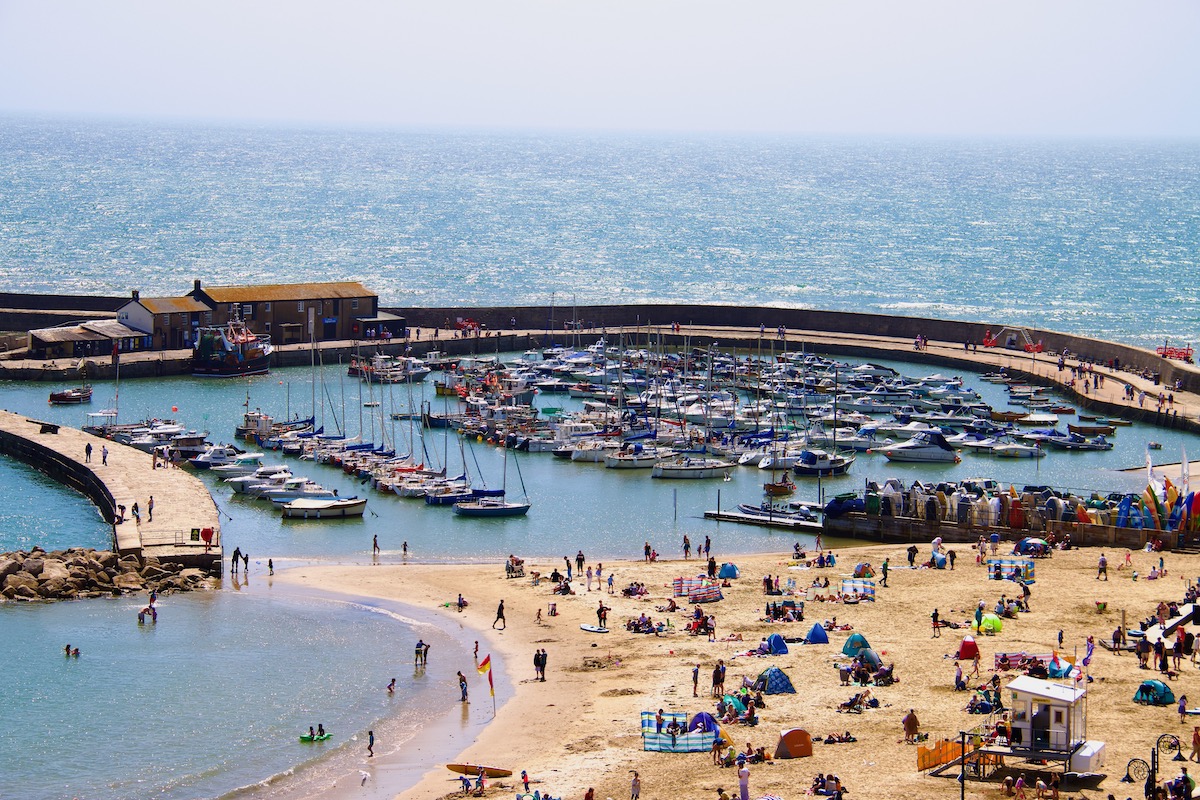
Fossils, fiction and films are just three facets of the fame association with the pretty seaside town of Lyme Regis on the UNESCO Jurassic Coast.
Writer John Fowles was a long-time resident here, and Jane Austen, who stayed in Lyme Regis, found inspiration there. It was used as the setting for the film The French Lieutenant’s Women and film adaptions of Persuasion by Jane Austen. Mary Anning, a famous palaeontologist lived in the town and became renowned for her work with fossils. She is commemorated by a bronze statue at the eastern end of the Long Entry. Also on Long Entry is a plaque recording and attempt by the famous novelist and playwright, Henry Fielding, to run away with Sarah Andrew the ward of a local merchant. Following the failure of this escapade Fielding fled the town the following day.

Fossils in Lyme Regis
Mary Anning, a famous palaeontologist and fossil collector, was born in Lyme Regis in 1799. As a child she would collect fossils from the town’s beaches and then sell them from her home. Mary was still very young when her father died and from that time the sale of fossils was the family’s only income. Mary also made some significant discoveries – the fossilised remains of marine reptiles. However, as she was a woman from a lower social class in Georgian England the importance of her work was not recognised until a long time after her death. But she has been honoured by a statue on the sea front depicting her and her dog. Fossils on the hem of her skirt are reminiscent of her habit of storing her finds in the hem of her skirt. Some of her finds are on display in the Natural History Museum in London as well as the Lyme Regis Philpot Museum.

The Museum in Lyme Regis
The Lyme Regis Philpot Museum was built on the site of the house where Mary Anning lived until she died in 1847. Inside the museum visitors will learn about Mary Anning’s important contribution to the development of modern science. Fossils are the main focus of this museum which features an interactive geology gallery, a learning centre and information about the famous writers associated with the town. There is a fossil shop in the new Mary Anning Wing which opened in 2017 and fossil hunting walks organised by the museum literally follow in the footsteps of Mary Anning. Next to this Museum is the Guildhall.

The Guildhall in Lyme Regis
Since the early seventeenth century Lyme Regis has boasted a Guildhall on the corner of Church Street and Bridge Street. Its present appearance is attributable to the architect George Vialls who also designed the Lyme Regis Museum on the other side of Cockmoile Square. The remodelling of the Guildhall took place in 1887 to mark Queen Victoria’s Jubilee. A new staircase, cells and an open arcaded market were added and the courtroom on the first floor was made larger. The only original features to survive were the panelling and the Venetian-style windows. Today, the town council occupies the space created on the ground floor when the arched market was closed in. The council holds its meetings in the court chamber on the first floor. This room is also available for weddings and civil ceremonies. An archway through the building behind the Guildhall on Bridge Street leads to the Marine Theatre.

The Marine Theatre in Lyme Regis
Overlooking the sea front the Marine Theatre is so much more than a theatre. The Marine, as it is known locally, has become an arts centre offering a diverse programme of events featuring artists and performers from across the country. Between 1806 and 1893, when sea bathing was fashionable, the building housed sea water baths. Water was pumped directly from the sea and the baths and fashionable reading room were a popular meeting place for locals and visitors. In 1893 the now dilapidated building was sold to Philpot, a prominent local man, and Lieutenant of the Volunteers. He turned it into a Drill Hall. It was used by soldiers to practice and perform military drills and staged performances by the local community. During the 1930s the building was remodelled and the front was rendered and painted white. It became the Marine Cinema. In 1946 Lyme Regis Council leased the theatre, referred to as the Marine Theatre, and subsequently bought the building in 1960. Since then it has flourished as an entertainment centre. A flight of stone steps leads down to the Sea Walls on Gun Cliff below the theatre.

The Sea Walls on Gun Cliff in Lyme Regis
Gun Cliff was the site of a battery of canons that defended the town from the Elizabethan era. It runs east from the small car park at Cobb Gate. A large anchor by the car park was donated by the Portland naval base to reflect the involvement of the town with all things marine over hundreds of years. This site was re-developed in 1995 as part of a coastal protection programme when old and new sea walls where integrated between Cobb Gate and Church Cliff. This new development included a sewage treatment plant. The only evidence of this is the ventilation tower in front of the Marine Theatre. Gun Cliff Walk links the walls with the East Cliff area of Lyme Regis on one side and the Marine Promenade on the other.

The Marine Parade in Lyme Regis
The River Lim (or Lym) flows into the sea just before Gun Cliff Walk joins the Marine Parade. At this point there are views back upstream of the Buddle Bridge. This bridge is thought to be the third oldest bridge in Dorset. It is Grade 1 listed and hidden under Bridge Street the main road through the town. Built between 1200 and 1240 the bridge only has one arch that survives in a nearby cellar. Due to several adaptions to widen the road for traffic only some of the original medieval masonry has survived, for example, the four equally spaced, pointed segmental, ashlar ribs made from Salcombe Stone.

Marine Parade runs from Cobb Gate at one end of the town to the bonded warehouses at The Cobb. Cart Road, the old route for goods between the harbour at The Cobb and the town, runs beneath Marine Parade. This path is lined by some of the most interesting buildings in Lyme Regis. The houses mainly date from the nineteenth century but vary in style from brick seaside villas, the thatched Madeira Cottages, Argyle House, Library Cottage (1830s) and Sundial House (1903) a four-storey Arts & Crafts style house. The row of buildings (cafés and pubs) at The Cobb end of the parade were built during the mid-eighteenth century. Bonded stores for the port once occupied the row of solid stone buildings opposite them. The Coastguard watch-house on the corner is now a fish shop. At the end of the parade The Cobb, a favourite among writers and film-makers.

The Cobb in Lyme Regis
The Cobb Is a breakwater that was built in the medieval period to protect ships in the harbour and the town beyond from the vagaries of the sea. Frequently damaged by storms and even swept away once it was virtually rebuilt using local Portland stone in 1817. Between 1500 and 1700 Lyme Regis was a major Channel port attracting ships and traders from all over the world. A flight of protruding steps connecting the lower and upper parts of The Cobb and known locally as Granny’s Teeth featured in Jane Austen’s novel Persuasion. The Cobb was also featured in the film The French Lieutenant’s Woman. Today it is a popular tourist attraction both to walk along and to visit the small marine aquarium housed in a converted building. Beyond this aquarium is the Victoria Pier for working boats. A complete contrast to the sea front in Lyme Regis are the beautiful gardens accessed from flights of steps along the Marine Parade.

The Gardens of Lyme Regis
Covering the slopes above the sea front of Lyme Regis are the blooms and shrubs of two gardens, the Jane Austen Gardens and the Langmoor and Lister Gardens. The Langmoor and Lister Gardens were created on land bought through a donation made to the town by the owner of Langmoor Manor. They were opened in 1913 and feature grassy banks, mature trees and shrubs, planted borders and gently curving paths including a shady Woodland Walk.

Elevated above the sea front and dotted with benches the gardens provide a delightful place to relax and enjoy the views across Lyme Bay and down to The Cobb. An added element of interest in the Langmoor and Lister Gardens is the Sculpture Trail. Also in these gardens is a sculpture of another famous son of Lyme Regis, Admiral Sir George Somers. Destined to become Mayor of Lyme Regis he was also an explorer and credited with discovering Bermuda when he was caught in a hurricane and shipwrecked on the island. He remained there for 10 months with the other passengers who founded the English colony of Bermuda.

The Jane Austen Gardens were opened in 1975 as a memorial to the writer. Jane’s Café, close to these gardens, occupies a building once known as Bay Cottage and featured in Persuasion. Lyme Regis enjoys a great literary heritage and many renowned writers have found inspiration here including Alfred Lord Tennyson, G.K. Chesterton and J.R.R. Tolkien. After visiting this pretty town, it is easy to understand why. For more information about Lyme Regis click here.
Available on GPSmyCity.com
This article is now featured on GPSmyCity. To download this article for offline reading or travel directions to the attractions highlighted in this article, go to Walking Tours in Lyme Regis on GPSmyCity
Valery Collins is the Experienced Traveller
 An excellent raconteur, Valery has been writing about her experiences on the road since she started travelling 25 years ago. After publishing four books she turned to online travel writing.
An excellent raconteur, Valery has been writing about her experiences on the road since she started travelling 25 years ago. After publishing four books she turned to online travel writing.